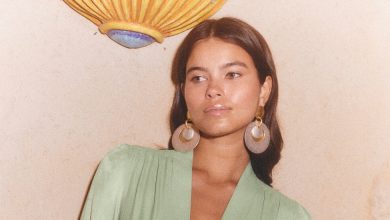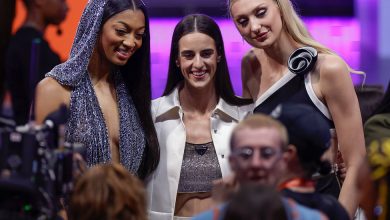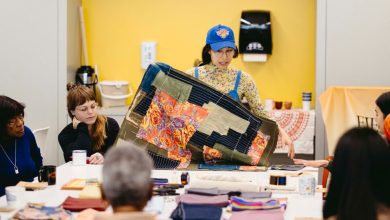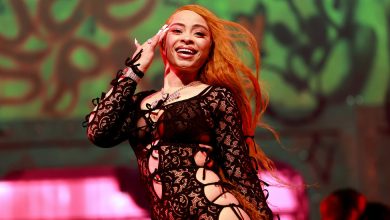Chaos and Creation: Inside the Making of Yeezy Gap

It was almost 90 degrees in Times Square on Thursday morning when a scene began to play out on Broadway that was so unexpected it could have been a mirage: 100 people were wrapped around the block outside the Gap, waiting for its doors to open.
Inside the store, which had been transformed into a kind of blackened cavern punctuated by digital screens, 24 industrial-size sacks were lined up in two long rows and stuffed with clothing from Yeezy Gap, the collaboration between the artist formerly known as Kanye West (now simply Ye) and the giant ur-American brand.
For anyone following the partnership since its buzzy birth more than two years ago, this was a major development: the first time customers would be able to see and touch the clothes inside a store — albeit not hung from racks or folded on shelves, but piled into those huge bags.
They would get to try on the unisex tees, double-layered hoodies and long-sleeve shirts in dark colors: tops with slightly skewed, look-again proportions, sometimes seamless or cropped, with dropped shoulders. When they swiveled in front of the fitting room mirrors, they would see images of doves in flight printed across their backs.
Ultimately they would get to judge for themselves how the boxy silhouettes and thick cotton differed from Gap’s typical offering — and decide whether that was enough to shift the fortunes of the brand: to make people across the country line up in anticipation, spend with alacrity and see Gap once again as a defining, disruptive staple of American fashion.
As opposed to viewing it as a corporation — Gap Inc. is the parent company of Gap, Banana Republic, Old Navy and Athleta — that is currently wrestling with the departure of its chief executive after only two years, along with diminishing profits (including a net $162 million loss in the first quarter of this year) and dwindling cultural relevance.
It was that uncool factor that seemingly drove Gap to announce, in June 2020, a 10-year deal with the undeniably cool Ye and his fashion line Yeezy, with the option to renew at the five-year mark, at which point Gap hoped Yeezy Gap would be generating $1 billion in annual sales. Though mass-market brands have engaged in one-off collaborations with high-end designers and celebrities for years, Yeezy Gap was, in scope and ambition, unlike any the retail world had seen.
Except that in its first 18 months, the partnership yielded just two products, both sold only online.
It wasn’t until a third party, Balenciaga, the French luxury house, entered the collaboration that a full Yeezy Gap collection was finally released this year (though it was still relatively small, with 36 styles in total unveiled in May). This weekend, a portion of the collection was rolled out in about 50 stores nationwide, in cities including Chicago, Dallas and San Francisco: a selection of eight styles, with more promised later in the year.
It is a milestone in the much-watched collaboration, but one that raises the question: What took so long?
When Corporate Meets Creative
Going into the Gap deal, Ye had a certain track record in the fashion-for-the-masses business; in 2020, the sneaker collaboration between Yeezy and Adidas brought in nearly $1.7 billion in revenue, according to Bloomberg.
He had less success in building a ready-to-wear brand. An early attempt at a glitzy namesake luxury label in Paris had fizzled, and a comeback with the more minimal, conceptual athleisure Yeezy yielded unpredictable results (including one widely criticized show on Roosevelt Island at which models fainted in the heat). Still, there was no denying his cultural influence and compulsive watchability.
Gap’s footing was less sure. In 2020, the brand’s net sales (about $3.4 billion) had been declining every year since 2013, largely in line with the demise of many traditional shopping malls (and not helped by the pandemic). That year, Gap Inc. said it would close 30 percent of its Gap and Banana Republic stores in North America, about 350 locations in total, by January 2024.
Industry wisdom said the company needed something big to stop the downward spiral. Ye was about as big as they come.
But he was not, as Mickey Drexler, who led Gap from 1983 to 2002, told Yahoo Finance in 2021, “a corporate person, and Gap is a big corporation,” with hierarchies, systems, calendars and fluency in SKUs. Mr. Drexler said he had advised Ye against the deal. “It doesn’t make any sense, in my opinion,” Mr. Drexler said at the time.
Julie Gilhart, the president of Tomorrow Projects, agreed. “In my experience, Gap was all about risk management,” she said. “They didn’t want to disgruntle anyone. And if you go with Kanye, you have to know there is risk involved.”
One week after the Yeezy Gap deal was announced, for example, he announced his run for president; a string of heated campaign remarks and tweets about his family compelled his wife at the time, Kim Kardashian West, to make a statement about his bipolar disorder.
But the controversy did not deter either side. They had agreed to an arrangement in which Ye’s fortunes were tied to those of his products; he received stock warrants that would vest when certain sales goals — such as reaching $250 million in a fiscal year, — were met, as well as royalties. (Gap has not disclosed the line’s sales figures to date.)
Ye — whose vision, according to Gap, was to create “modern, elevated basics for men, women and kids at accessible price points” — got to work, bringing on the Nigerian-British designer Mowalola Ogunlesi as design director and testing out pieces as early as the summer of 2020. (Ms. Ogunlesi left after a year, at the expiration of her contract.)
According to two people who worked on the collaboration, the original goal was to have a collection ready by Singles Day, an annual Chinese shopping event, in November 2020. The garments were conceived to be relatively affordable, priced around $50.
Images from that period shared with The New York Times showed brightly colored pants, shorts, shirts, hoodies and belts, all in line with the traditional casual clothing associated with Gap. (In a video shared on Twitter by Ye from a fitting in July 2020, at least one tie-dye-effect pink and purple bodysuit is visible.) At the time, there were numerous “style-ups” — a fashion term that means trying out samples of clothing on bodies to see how they look — photographed by Nick Knight, the SHOWStudio founder and longtime Yeezy collaborator, and paid for by Gap.
But these designs were never put into production, despite what the two former employees described as long hours and mounting impatience from Gap over missed deadlines — and despite the fact that it is almost unheard-of in the industry to eliminate almost an entire collection once samples have been made.
According to Zac Posen, who has worked with Target, Brooks Brothers and David’s Bridal, as well as having his own fashion line, the “standard” ratio of sample garments that ultimately end up in stores was historically 2 to 1 (for every two samples, one was chosen and one discarded). Though Mr. Posen said he had “heard of 3 to 1 or even 4 to 1, that’s less common these days,” as brands, especially public brands like Gap, become more oriented to the bottom line.
Ye, however, was widely known to be both a perfectionist and a nonconformist.
“I don’t think his mentality is at all the mentality we see in more classic fashion houses,” said Mr. Knight, the photographer. “If he wants to spend a year looking into the color blue, we’ll spend a year looking into the color blue, which is extremely inspiring when so often schedules take priority over creativity. He doesn’t see himself in any way constrained by deadlines or seasons. I don’t think he would even use the word ‘collection’ for what he is doing.”
Referring to the 2020 designs that weren’t put into production, a Gap spokeswoman said in an email that “a collection was not discarded; this was part of the creative process. The team was intentional about iterating until they were satisfied.” The broader goal was “product development, testing and learning.”
One early product that survived the creative process was the “round jacket,” a puffy jacket with no closures made from recycled nylon and polyester fill.
This was Yeezy Gap’s first piece, made available for purchase in June 2021, nearly one year after the partnership was announced. It was sold for $200 in three colors (first blue, then black and later red), and those who preordered received the jacket about five months later.
Yeezy Gap’s second piece dropped online a few months later: a plain, heavy cotton hoodie in six colors for $90. Ye later claimed that after airing a commercial featuring the hoodie, Gap sold $14 million worth of the black version. (Gap would not confirm this figure, though previously said the hoodie broke its single-day online sales record.)
Its name? The “perfect hoodie.”
The Balenciaga Factor
Between the puffer and the hoodie, Gap intervened, hiring Leonardo Lawson, the former chief executive of the British brand the Vampire’s Wife, to help drive strategy for Yeezy Gap — with Ye’s blessing, Mr. Lawson said. (Ye did not respond to requests for comment for this article.)
Mr. Lawson’s directive has essentially been to build a conduit between Yeezy and Gap, acting as a translator of sorts. He helped opened a Los Angeles office for Yeezy Gap, whose operations had previously been spread out across several cities, depending on where Ye and his core team were at any given time. This “innovation studio” today houses about 20 employees, said Mr. Lawson, who was promoted to head of Yeezy Gap in March.
“We’re constantly flexing, depending on the needs, and helping each side understand what the asks are, why things need to be done, what maybe we cannot do,” he said.
Mr. Lawson was asked about the early structural difficulties of the partnership. “When I came here, to be honest, I saw it,” he said. “I think everyone knows and understands that Ye’s background and pedigree and fashion is really working with luxury houses and ateliers in Europe. Those systems and how those companies work and are set up are very different than how a company like Gap is set up. So it was really about bringing these two worlds together.”
Meanwhile, Ye, who released his album “Donda” the same month Mr. Lawson was brought on board, had already asked Demna to get involved.
The mononymous creative director of Balenciaga had worked with Ye on his first Yeezy collection, “Season 1,” in 2015, and the two men have maintained an ongoing creative conversation via WhatsApp and text — Ye’s preferred means of communication — ever since.
“Ye called me in March 2021 telling me he was working on this project, and it was his dream for me to work together with him on it,” Demna said this month. “He said this is what he needs there: to bring this know-how to the brand, bring the structure; fittings, atelier, patternmaker. The way they were doing things was more trying them on and styling rather than constructing.”
Though he was busy with several Balenciaga collections, Demna said he felt the need to “be there for him to help him create a solid foundation for Ye’s aesthetic on which they can now build. To accelerate the process.” Hence the name of the collaboration: “engineered by Balenciaga.” They were, Demna said, engineering the prototypes in the Balenciaga studios in Paris and Zurich after he and Ye talked (or texted) through the ideas.
“Lots of talking, thousands of images shared,” he said of their exchanges. They talked about how Ye wanted a “fabric that is very light but also warm and makes no sound — kind of like nylon, but not nylon. Things that seemed to be impossible or very hard to make technically.
“Ye’s not really interested in fashion at all,” Demna said. “He wants to know: ‘How can we make a new version of the hoodie? What’s next? What do we want to wear in 20 years?’”
Then, Demna said, once “the shape was there, I would make a decision — OK, it’s ready, we launch it.” At that point, he would send the designs to Ye and the Gap teams in Los Angeles, after which they would “start the process on how to industrialize them.” (Ye also went to Paris, and Mr. Lawson said prototypes were also created by the Yeezy Gap team in Los Angeles, and characterized the work as a three-way partnership.)
“Me being on board gave him reassurance,” Demna said, “so there could be a moment of letting go.”
And the clothes, which included a catsuit ($300), cargo pants ($220) and thigh-high boots (coming later this year), could, with the help of the strengthened Los Angeles infrastructure, make it out of the experimental phase and into the public’s waiting hands.
The first Yeezy Gap Engineered by Balenciaga (or YGEBB, as it’s called internally) designs were made available for purchase online in late February.
A week later, Ye was in the news again, for a music video in which an animated version of himself buries Pete Davidson, Ms. Kardashian’s new boyfriend, alive.
What Happens Now?
Gap’s preferred word to explain the unconventional production timeline of Yeezy Gap is “fluid.”
The work with Balenciaga “really has been a fluid collaboration,” Mr. Lawson said. The entire experience of building Yeezy Gap “has been about being fluid,” and “creating new ways of doing things, and understanding how these ways of doing things will impact the bigger Gap brand and help everything be a little bit more fluid.”
But is fluidity enough to help Gap make a profit? This spring, before the largest Yeezy Gap drop to date (the Balenciaga collection in late May), analysts who spoke to The Times were skeptical of Ye’s long-term effect on Gap as a company.
“Anyone who was excited about the Yeezy partnership when it was announced is disappointed with the amount of product that is coming out,” said Simeon Siegel, a retail analyst at BMO Capital Markets.
The discussion around Yeezy Gap has largely morphed from focusing on sales to focusing on buzz. And Gap is investing considerably in that buzz: in addition to fees Ye has already been or will be paid for the collection — and the costs of maintaining the innovation studio, as well as its sampling and production — Gap also provides support for music videos and concerts that feature Yeezy Gap products.
“The Yeezy line was never going to be big enough to change Gap’s fortunes,” Mr. Siegel said. “It needed to be powerful enough to elevate the rest of Gap’s brand, and we clearly have not seen that.”
With the advent of the in-store product, however, that could change. Already 70 percent of Yeezy Gap’s customers are first-time Gap customers, the company said during an earnings call last year.
Mr. Lawson said that Gap interim leadership is fully committed to the Yeezy Gap vision. Ye himself posted a recent statement on Instagram after a call with Gap management calling the executive chairman Bob Martin “one of the most inspiring people I’ve heard speak in business.”
“Bob I need to meet with you as soon as possible,” he wrote. (This may not be the way Mr. Martin usually sets up meetings, but according to a Gap spokeswoman, the appointment was already in motion.)
According to Demna, Balenciaga’s work on the project is now over, and he’s not sure what will happen next. But Yeezy Gap has its sights on other future partnerships, in addition to growing its core business. There is a structure in place to adapt and iterate for the future: Yeezy Gap engineered by … fill in the bank.
As Demna said, when it comes to Ye: “This was just step No. 1. He needed a starting point, and that was my challenge: to give him the starting point. But he is still miles and miles away from where he wants this to go.”



